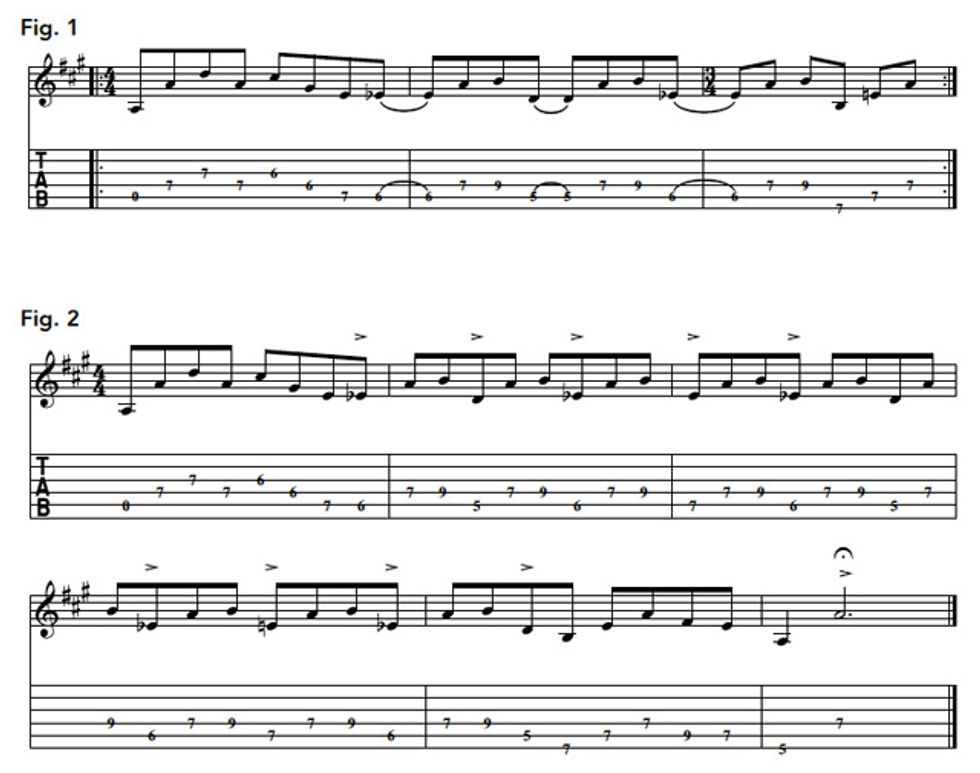What begins as an inspired, creative groove
can sometimes become a rut over time. Once
our ears hear something new, we train our
fingers to go there, and it’s an exciting time
musically. We learn new ideas for improvising
and create new compositional ideas that
way. At some point, however, it’s bound to
happen: Our ears aren’t feeding us any new
ideas, and our fingers are playing the same
melodic lines that they learned back when we
practiced with cassette tapes.
Think It Through
I wrote the song “Once Around the Sun” as
an exercise that came from a concept I was
turned onto by jazz guitarist Emily Remler.
The idea was to create lines that only use the
intervals of fourths and seconds as a way to
force myself into new territory and away from
familiar licks. You can change the exercise to
use any one or two intervals as a restriction.
The idea is to think it through intellectually,
rather than simply letting your ears or fingers
guide you as they habitually would. As a
result, your ears and fingers both learn something
new, sending you on a creative path full
of fresh melodies and ideas.
Fig. 1 is an excerpt from “Once Around
the Sun.” As you can see, once I put
the ideas from the practice into a song,
I allowed myself some latitude with the
restrictions of the intervals. The idea is to
have a fresh place to start that will lead
to a new musical story. Start by playing
in the seventh position. Shift to the sixth
position on beat 3 of the first measure,
and with your first finger, stretch back for
the D on the “and” of beat 2 in measure
two. Shift back to the seventh position on
the “and” of beat 2 in the third measure,
which is in 3/4 time. The meter change
was not planned, by the way. This is an
example of letting the melody present
itself, as it seemed to want to be played.
It was only after I learned to play it and
listen to it that I figured out the quirky
time scheme.
The line shown in Fig. 2 comes from the
song’s coda. You can see that the ties from
the first section of the song are gone.
The result is the phrases now seem to
run together, rather than having the clear
separation they had in the first line, which
was made even more clear by the accents
on the lowest note of each phrase. You’ll
notice the accents are still on the lowest
note of each phrase, but they fall in unexpected
places.
Making Friends with Seconds and Fourths
If you analyze the intervals, you’ll find
fourths played forward and backward,
making fifths descending, such as A to D
and back down to A. The occasional third
seemed to set up a new section of fourths,
so I let it be a way into a new melodic section
in spots.
As for the intervals of a second, you’ll see
a minor second descending in measure
1 (E to Eb) and a major second ascending
in measure 2 (A to B). Measure 5 has
a descending major second (F# to E) as a
characteristic sound.
Learning the fingering to this melodic
example could show you new patterns
that involve fourths and seconds—along
with thirds and fifths—that could work
their way into your improvised lines. Keep
your ears alert for the sound of these
angular lines and listen to your own new
ideas develop.
Jane Miller
Guitarist, composer, and arranger Jane Miller is has roots in both jazz and folk. In addition to leading her own jazz instrumental quartet, she is in a working chamber jazz trio with saxophonist Cercie Miller and bassist David Clark. The Jane Miller Group has released three CDs on Jane’s label, Pink Bubble Records. Jane joined the Guitar Department faculty at Berklee College of Music in 1994. You can reach her at janemillergroup.com.










![Rig Rundown: Russian Circles’ Mike Sullivan [2025]](https://www.premierguitar.com/media-library/youtube.jpg?id=62303631&width=1245&height=700&quality=70&coordinates=0%2C0%2C0%2C0)







